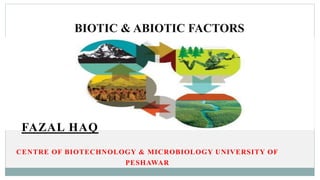
Biotic & Abiotic Factors
- 1. FAZAL HAQ CENTRE OF BIOTECHNOLOGY & MICROBIOLOGY UNIVERSITY OF PESHAWAR BIOTIC & ABIOTIC FACTORS
- 3. Biotic factors: It is also known as Biological components / living factors , simply means Living organisms. Biotic Components are further classified into 3 main groups Producers Consumers Decomposers
- 4. Producer Producers are autotrophs which can prepare their own food. Chloroplast helps in preparing food. They can store light and chemical energy. They are placed at the primary level in the food chains. Examples: Green plants, algae and a few phtosynthetic bacterias.
- 5. Consumers Consumers are heterotrophs who depend on producers for food. They lack chloroplast and are unable to synthesis their own food. They are placed in secondary or tertiary level in food chain. It can move from one place in to another in search of food and shelter.
- 6. Types of consumers The Consumers are of 4 types: (a) Primary Consumer: ( Herbivores) i.e. Animal feeding on plants, e.g. Rabbit, deer, sheep etc. (b) Secondary Consumers: The animal feeding on Herbivores are called as secondary consumers or primary carnivores. E.g. Cats, foxes, snakes.
- 7. © Tertiary Consumers: These are large carnivores which feed on secondary consumers. E.g. Wolves (d) Quaternary Consumers: These are largest carnivores which feed on tertiary consumers and are not eaten up by any other animals. e.g. lion and Tiger.
- 8. Decomposers: Their primary purpose in the ecosystem is to decompose producers and consumers (usually dead) into simpler form which can be reused
- 9. ABIOTIC COMPONENTS: The non living factor or the physical environment prevailing in an ecosystem forms abiotic components. • Abiotic component are mainly of two types, 1. Climatic factors It includes, rain, temperature, light, wind, humidity, etc. 2. Edaphic factors (i.e. factors related to soil) : It includes soil, pH, topography, minerals.
- 10. light Light is the energy source for all living things. The main source of light on earth is sunlight. Light is essential for photosynthesis. It is only possible when sunlight is avaiable as a source of energy.
- 11. Temperature The average temperature on land varies seasonally, decrease progressively from equator towards the poles and from plains to the mountains. Protein desturction at 41C. Death occur at 45c. Metabolic activities slow down at 34C.
- 12. Water Earth surface contain 75% of water. Organisms cannot surive with out water. Life on earth originated in water and is unstainable without water. The productivity and distribution of plants is also heavily dependent on water.
- 13. Soil Important natural resource. Soil is a haibtat for several organisms such as earth worm, snails, snakes, ants etc. Soil, water, air, organic and inorganic molecules are very important for plant growth The ratios of these 4 groups in the soil are as follows: - Minerals (Ca, Mg, P, N): 45% - Organic molecules (plant and animal residues): 5% - Air: 25% - Water (soil water with dissolved salts): 25%
- 14. Thanks For Your Listening.
Editor's Notes
- 1